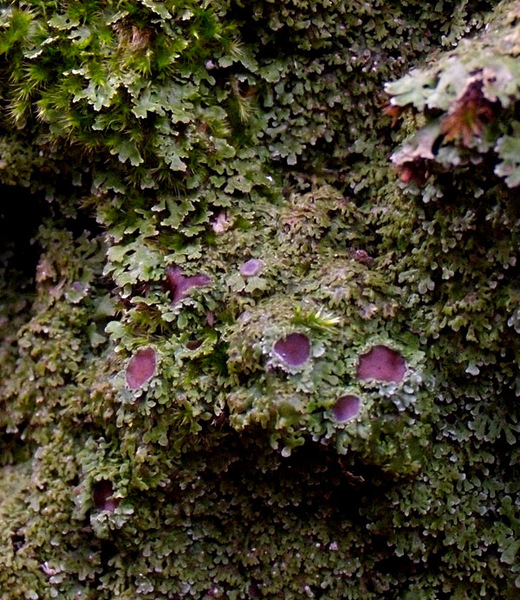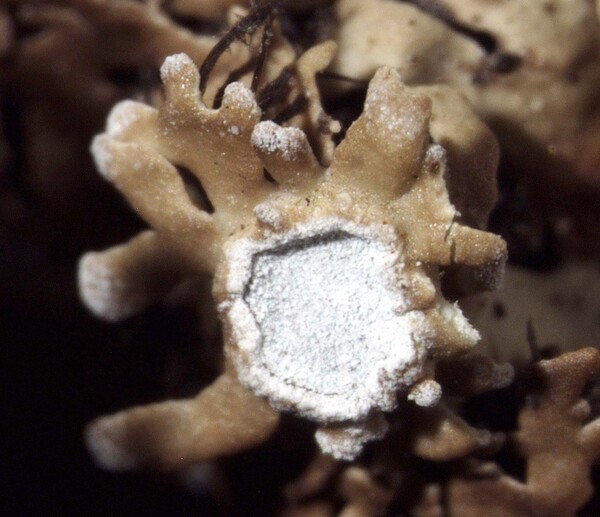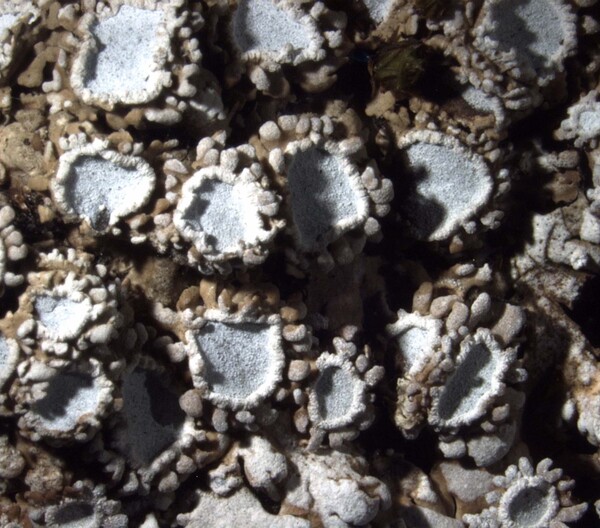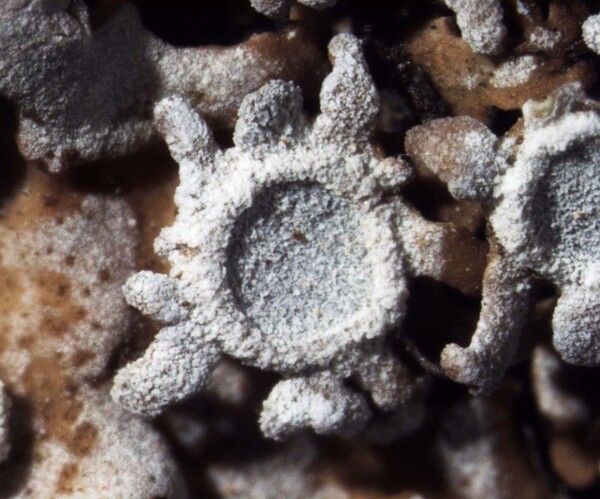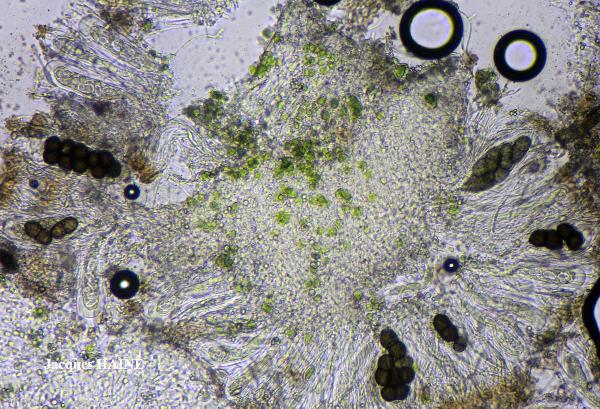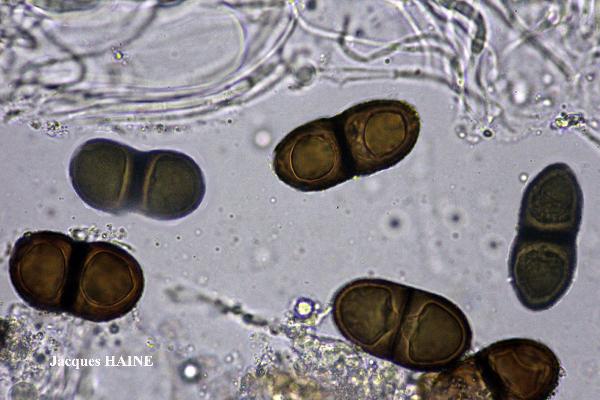Physconia venusta (Ach.) Poelt
Nova Hedwigia, 12: 130, 1966. Basionym: Parmelia venusta Ach. - Meth. Lich.: 211, 1803.
Synonyms: Parmelia hybrida (Ach.) Röhl.; Physcia amoena (Zahlbr.) Nádv.; Physcia pulverulenta var. venusta (Ach.) Nyl.; Physcia subaquila auct. non Nyl.; Physcia venusta (Ach.) Nyl.; Poeltonia venusta (Ach.) S.Y. Kondr., Lőkös & Hur
Distribution: N - Ven (Nascimbene & Caniglia 2003c), TAA (Nascimbene & al. 2007b), Lomb (Zocchi & al. 1997, Litterski & Otte 2002, Chiappetta & al. 2005), Emil (Benesperi 2009, Brackel 2015, Fariselli & al. 2020), Lig (Brunialti & al. 1999, Giordani & al. 2002, Brunialti & Giordani 2003). C - Tosc (Tretiach & Nimis 1994, Loppi & Putortì 1995, 1995b, Loppi & al. 1995, 1996b, 1996c, 1997, 1997b, 1998, 1998b, 2002b, 2002c, 2004, 2004c, Loppi 1995c, 1996, Loppi & De Dominicis 1996, Loppi & Nascimbene 1998, 2010, Putortì & al. 1998, 1999, Tretiach & Ganis 1999, Putortì & Loppi 1999b, Del Guasta 2001, Laganà & al. 2002, Loppi & Frati 2006, Paoli & Loppi 2001, Benesperi & al. 2007, Lastrucci & al. 2009, Brunialti & Frati 2010, Benesperi 2011, Paoli & al. 2012, Brackel 2015, 2025, Frati & Brunialti 2023), Marc (Nimis & Tretiach 1999, Frati & Brunialti 2006, Brackel 2015), Umb (Ravera 1998, Panfili 2000b, 2007, Ravera & al. 2006, Brackel 2015), Laz (Ravera 2002, Litterski & Otte 2002, Massari & Ravera 2002, Nimis & Tretiach 2004, Ruisi & al. 2005, Ravera & Genovesi 2008, Zucconi & al. 2013, Brackel 2015), Abr (Recchia & al. 1993, Olivieri & al. 1997, 1997b, Loppi & al. 1999, Nimis & Tretiach 1999, Stofer 2006, Brackel 2015, Caporale & al. 2016, Corona & al. 2016, Gheza & al. 2021), Mol (Garofalo & al. 1999, Nimis & Tretiach 1999, Caporale & al. 2008, Genovesi & Ravera 2014, Paoli & al. 2015, Brackel 2020, Caporale & Ravera 2020), Sar (Zedda 1995, 2002, 2002b, Loi & al. 2000, Zedda & Sipman 2001, Zedda & al. 2001, Litterski & Otte 2002, Otte & al. 2002, Stofer 2006, Rizzi & al. 2011, Cossu 2013, Neuwirth 2018, Brackel & Berger 2019, Di Nuzzo & al. 2022). S - Camp (Garofalo & al. 1999, 2010, Aprile & al. 2002, 2003, 2003b, 2011, Nimis & Tretiach 2004, Brunialti & al. 2010, 2013, Nascimbene & al. 2010b, Ravera & Brunialti 2013, Catalano & al. 2016), Pugl (Garofalo & al. 1999, Nimis & Tretiach 1999, Brackel 2011), Bas (Nimis & Tretiach 1999, Litterski & Otte 2002, Fascetti & al. 2005, Potenza & Fascetti 2010, Brackel 2011, Cassola & al. 2025), Cal (Puntillo 1995, 1996, Litterski & Otte 2002, Puntillo & Puntillo 2004, Incerti & Nimis 2006, Brackel & Puntillo 2016), Si (Ottonello & al. 1994, Grillo & Cristaudo 1995, Ottonello 1996, Litterski & Otte 2002, Merlo 2004, Falco Scampatelli 2005, Stofer 2006, Brackel 2008c, Liistro & Cataldo 2011, Puglisi & Cataldo 2019, Campisi & al. 2020).
Description: Thallus foliose, heteromerous, dorsiventral, loosely attached, forming 5-15(-20) cm wide rosettes. Lobes strap-shaped, 1-3 mm wide, highly branched, rather fragile, contiguous to overlapping, slightly palmate towards apices, often with secondary lobules especially in central parts. Upper surface grey to grey-brown, coarsely white-pruinose at least at lobe-tips; lower surface dull whitish, arachnoid, with black, squarrosely branched rhizines. Upper cortex prosoplectenchymatous, the hyphae running, at least in part, parallel to the surface; medulla white. Apothecia usually numerous, 0.3-0.8(-1.2) mm across, with a brown-black but frequently white-pruinose disc and a thalline margin typically fringed with numerous lobules, giving them a daisy aspect. Epithecium brown; hymenium and hypothecium colourless; paraphyses slender, simple or forked in upper part, the apical cells clavate, with a thin, dark brown cap. Asci (2-6-)8-spored, elongate-clavate, the K/I+ blue tholus penetrated by a faintly amyloid apical cushion with parallel or diverging flanks, the wall K/I-, surrounded by a K/I+ blue outer layer, Lecanora-type. Ascospores 1-septate, brown, broadly ellipsoid, 25-35(-40) x 13-20 µm, thickened at septum but not at apices, Physconia-type. Photobiont chlorococcoid. Spot tests: cortex and medulla K-, C-, KC-, P-, UV-. Chemistry: without lichen substances.
Note: one of the few lichens whose distribution is centred on the Mediterranean mountains, and one of the most abundant and typical lichens of the central and south Italian humid beech forests, which is very rare in the Alps. An earlier record from Piemonte (see Nimis 1993: 543) and the recent ones from Piemonte (Castino 2004) and Rome (Munzi & al. 2007), being dubious, are not accepted here.
Growth form: Foliose, narrow lobed
Substrata: bark
Photobiont: green algae other than Trentepohlia
Reproductive strategy: mainly sexual
Commonnes-rarity: (info)
Alpine belt: absent
Subalpine belt: absent
Oromediterranean belt: absent
Montane belt: very common
Submediterranean belt: extremely rare
Padanian area: absent
Humid submediterranean belt: rare
Humid mediterranean belt: absent
Dry mediterranean belt: absent

Predictive model
Herbarium samples
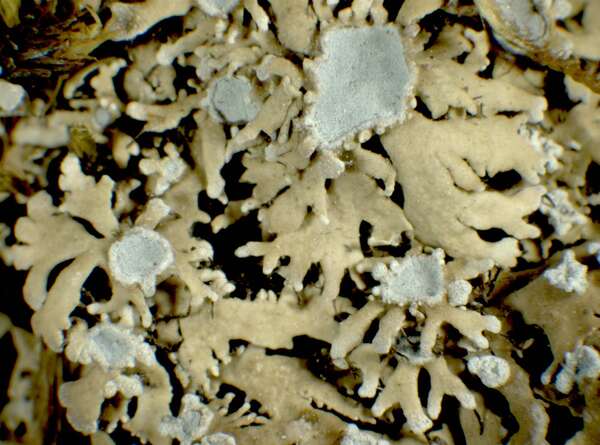

P.L. Nimis; Owner: Department of Life Sciences, University of Trieste
Herbarium: TSB (11435)
2001/12/05


P.L. Nimis; Owner: Department of Life Sciences, University of Trieste
Herbarium: TSB (34319)
2001/12/24
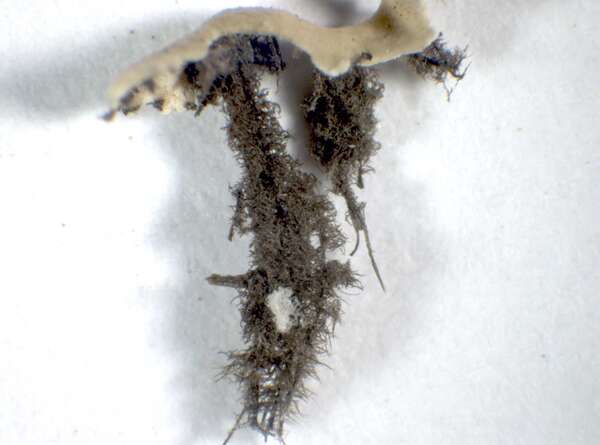

P.L. Nimis; Owner: Department of Life Sciences, University of Trieste
Herbarium: TSB (11435)
2001/12/05
detail of rhizines
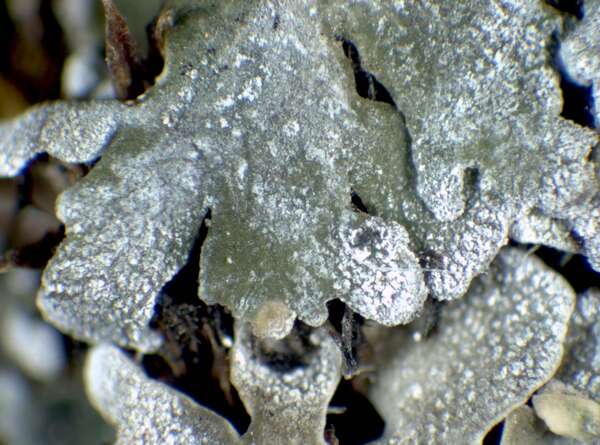

P.L. Nimis; Owner: Department of Life Sciences, University of Trieste
Herbarium: TSB (34319)
2001/12/24
tip of lobes with pruina
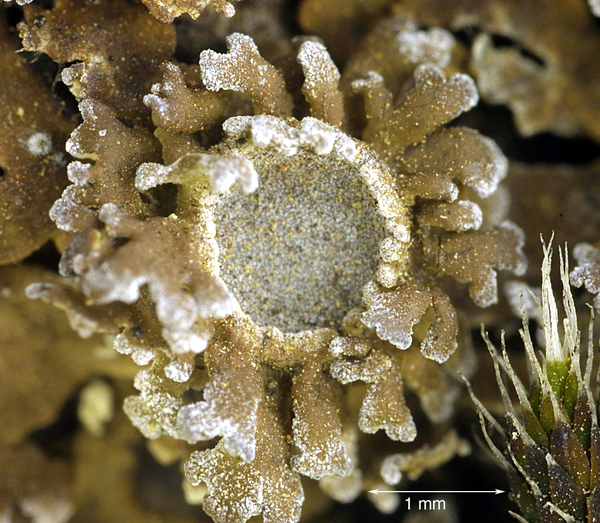

Felix Schumm – CC BY-SA 4.0
[5163], Spanien, Gran Canaria, ca. 1,5 km südlich La Culata; felsiger trockener Nordhang, lückig mit Pinus canariensis bewachsen; 27°57.848 N, 15°36.136 W, 1570 m. Leg. F. Schumm & U Schwarz, 25.12.1998
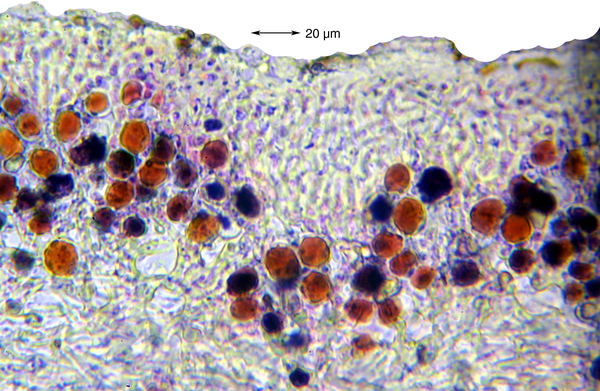

Felix Schumm – CC BY-SA 4.0
[5163], Spanien, Gran Canaria, ca. 1,5 km südlich La Culata; felsiger trockener Nordhang, lückig mit Pinus canariensis bewachsen; 27°57.848 N, 15°36.136 W, 1570 m. Leg. F. Schumm & U Schwarz, 25.12.1998


Felix Schumm – CC BY-SA 4.0
[5163], Spanien, Gran Canaria, ca. 1,5 km südlich La Culata; felsiger trockener Nordhang, lückig mit Pinus canariensis bewachsen; 27°57.848 N, 15°36.136 W, 1570 m. Leg. F. Schumm & U Schwarz, 25.12.1998


Felix Schumm – CC BY-SA 4.0
[5163], Spanien, Gran Canaria, ca. 1,5 km südlich La Culata; felsiger trockener Nordhang, lückig mit Pinus canariensis bewachsen; 27°57.848 N, 15°36.136 W, 1570 m. Leg. F. Schumm & U Schwarz, 25.12.1998
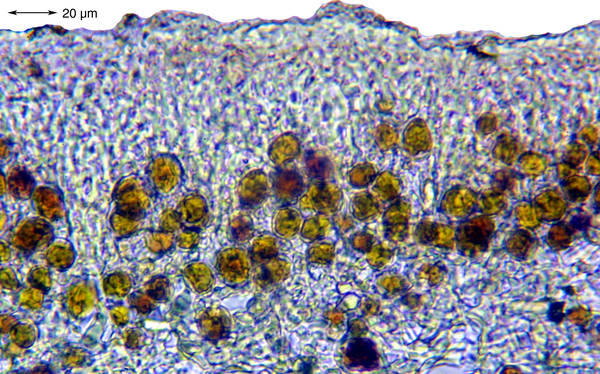

Felix Schumm – CC BY-SA 4.0
[5163], Spanien, Gran Canaria, ca. 1,5 km südlich La Culata; felsiger trockener Nordhang, lückig mit Pinus canariensis bewachsen; 27°57.848 N, 15°36.136 W, 1570 m. Leg. F. Schumm & U Schwarz, 25.12.1998
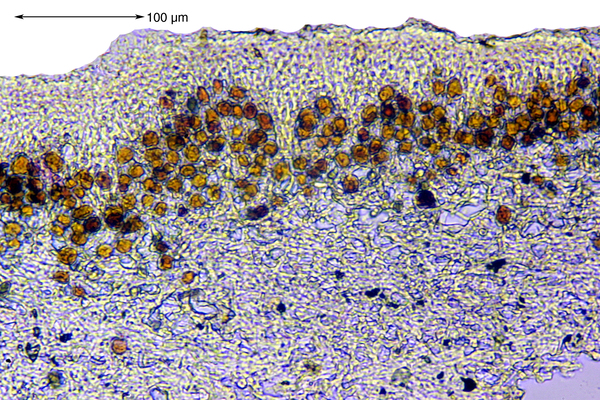

Felix Schumm – CC BY-SA 4.0
[5163], Spanien, Gran Canaria, ca. 1,5 km südlich La Culata; felsiger trockener Nordhang, lückig mit Pinus canariensis bewachsen; 27°57.848 N, 15°36.136 W, 1570 m. Leg. F. Schumm & U Schwarz, 25.12.1998
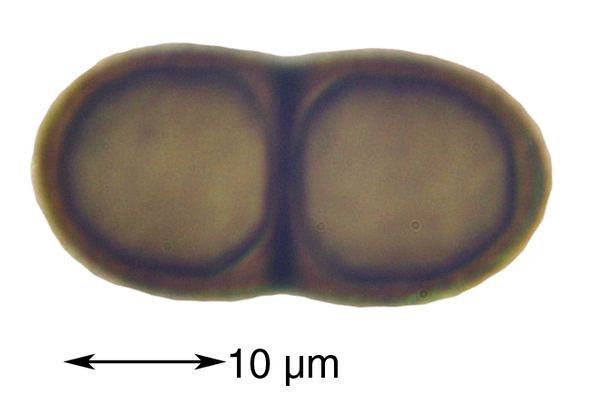

Felix Schumm – CC BY-SA 4.0
[5163], Spanien, Gran Canaria, ca. 1,5 km südlich La Culata; felsiger trockener Nordhang, lückig mit Pinus canariensis bewachsen; 27°57.848 N, 15°36.136 W, 1570 m. Leg. F. Schumm & U Schwarz, 25.12.1998
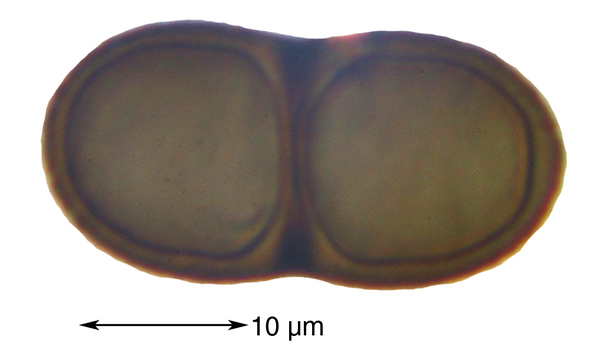

Felix Schumm – CC BY-SA 4.0
[5163], Spanien, Gran Canaria, ca. 1,5 km südlich La Culata; felsiger trockener Nordhang, lückig mit Pinus canariensis bewachsen; 27°57.848 N, 15°36.136 W, 1570 m. Leg. F. Schumm & U Schwarz, 25.12.1998
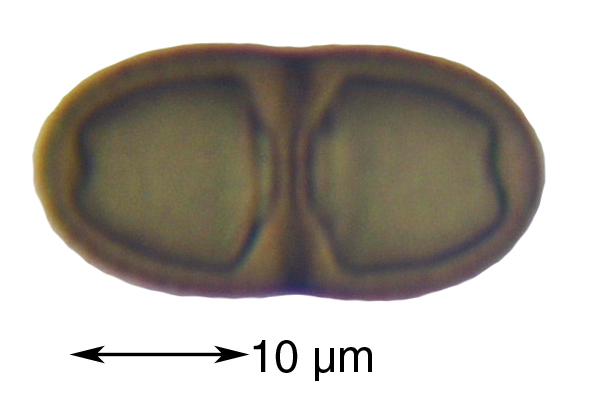

Felix Schumm – CC BY-SA 4.0
[5163], Spanien, Gran Canaria, ca. 1,5 km südlich La Culata; felsiger trockener Nordhang, lückig mit Pinus canariensis bewachsen; 27°57.848 N, 15°36.136 W, 1570 m. Leg. F. Schumm & U Schwarz, 25.12.1998
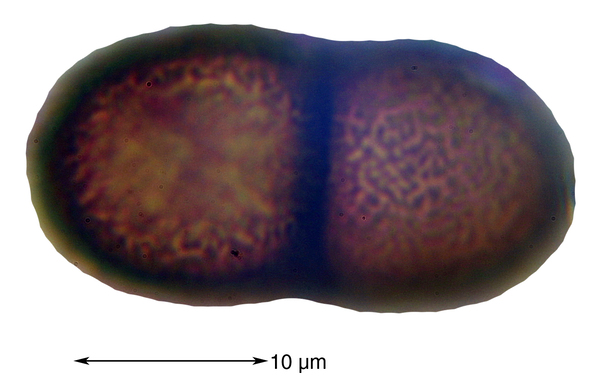

Felix Schumm – CC BY-SA 4.0
[5163], Spanien, Gran Canaria, ca. 1,5 km südlich La Culata; felsiger trockener Nordhang, lückig mit Pinus canariensis bewachsen; 27°57.848 N, 15°36.136 W, 1570 m. Leg. F. Schumm & U Schwarz, 25.12.1998
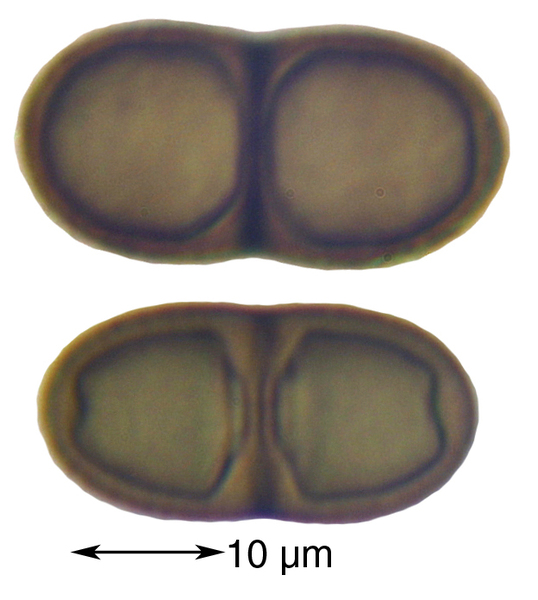

Felix Schumm – CC BY-SA 4.0
[5163], Spanien, Gran Canaria, ca. 1,5 km südlich La Culata; felsiger trockener Nordhang, lückig mit Pinus canariensis bewachsen; 27°57.848 N, 15°36.136 W, 1570 m. Leg. F. Schumm & U Schwarz, 25.12.1998
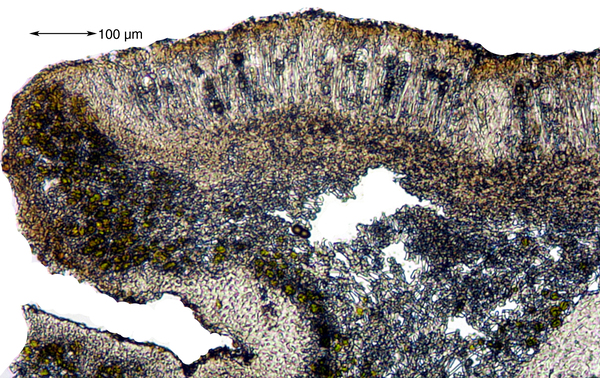

Felix Schumm – CC BY-SA 4.0
[5163], Spanien, Gran Canaria, ca. 1,5 km südlich La Culata; felsiger trockener Nordhang, lückig mit Pinus canariensis bewachsen; 27°57.848 N, 15°36.136 W, 1570 m. Leg. F. Schumm & U Schwarz, 25.12.1998
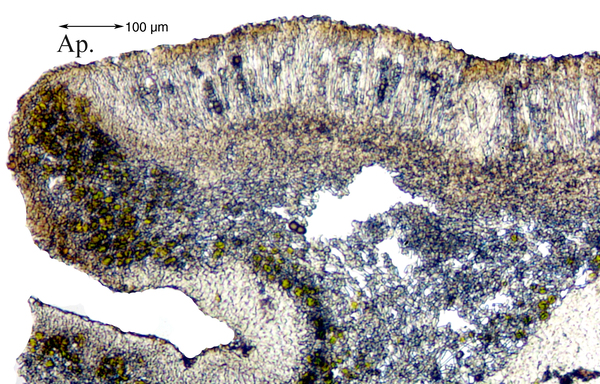

Felix Schumm – CC BY-SA 4.0
[5163], Spanien, Gran Canaria, ca. 1,5 km südlich La Culata; felsiger trockener Nordhang, lückig mit Pinus canariensis bewachsen; 27°57.848 N, 15°36.136 W, 1570 m. Leg. F. Schumm & U Schwarz, 25.12.1998
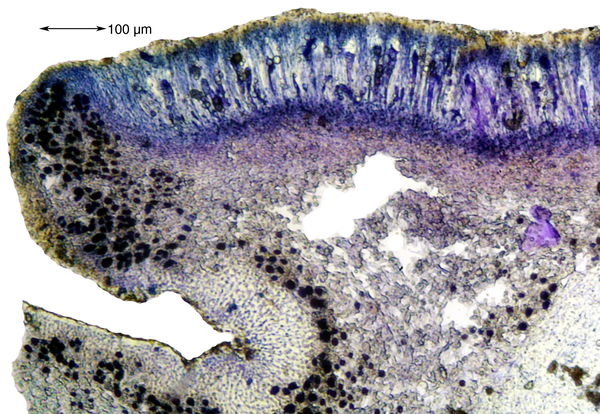

Felix Schumm – CC BY-SA 4.0
[5163], Spanien, Gran Canaria, ca. 1,5 km südlich La Culata; felsiger trockener Nordhang, lückig mit Pinus canariensis bewachsen; 27°57.848 N, 15°36.136 W, 1570 m. Leg. F. Schumm & U Schwarz, 25.12.1998
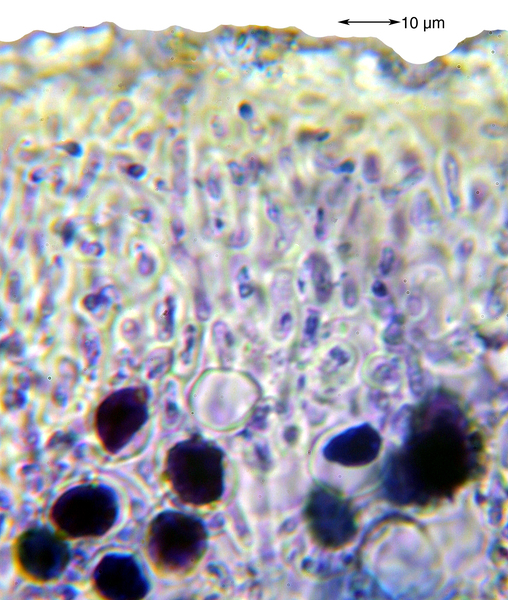

Felix Schumm – CC BY-SA 4.0
[5163], Spanien, Gran Canaria, ca. 1,5 km südlich La Culata; felsiger trockener Nordhang, lückig mit Pinus canariensis bewachsen; 27°57.848 N, 15°36.136 W, 1570 m. Leg. F. Schumm & U Schwarz, 25.12.1998
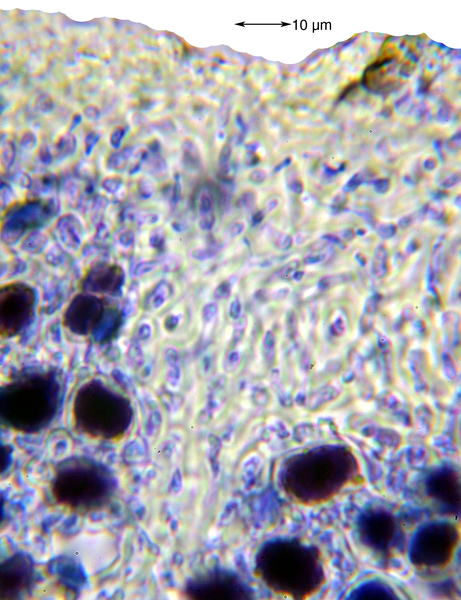

Felix Schumm – CC BY-SA 4.0
[5163], Spanien, Gran Canaria, ca. 1,5 km südlich La Culata; felsiger trockener Nordhang, lückig mit Pinus canariensis bewachsen; 27°57.848 N, 15°36.136 W, 1570 m. Leg. F. Schumm & U Schwarz, 25.12.1998
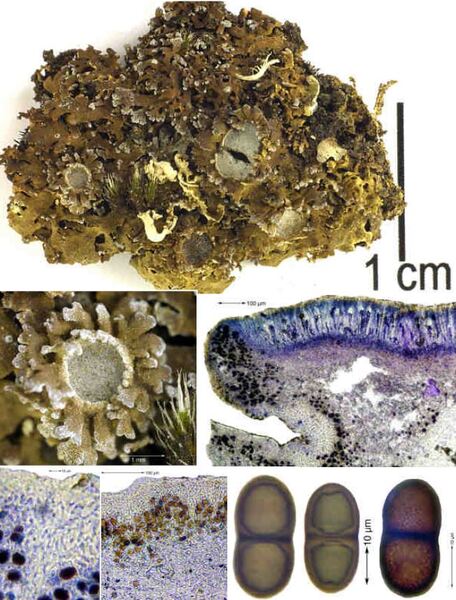

Felix Schumm – CC BY-SA 4.0
Image from: F. Schumm (2008) - Flechten Madeiras, der Kanaren und Azoren. Beck, OHG - ISBN: 978-3-00-023700-3
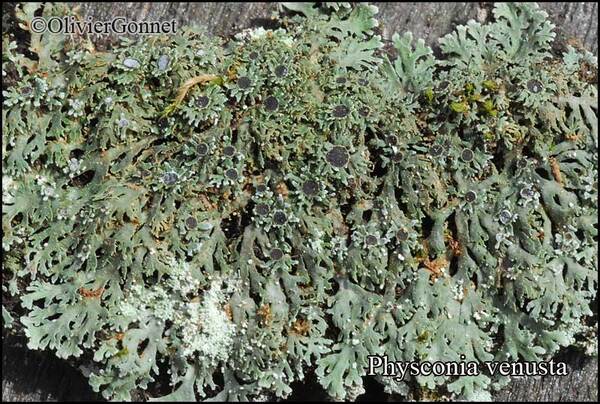
Courtesy Danièle et Olivier Gonnet - Source: https://www.afl-lichenologie.fr/Photos_AFL/Photos_AFL_P/Physconia_venusta.htm
France, 11/10/2018 - Ajaccio, Pointe de la Parata, alt.5 m - Corse
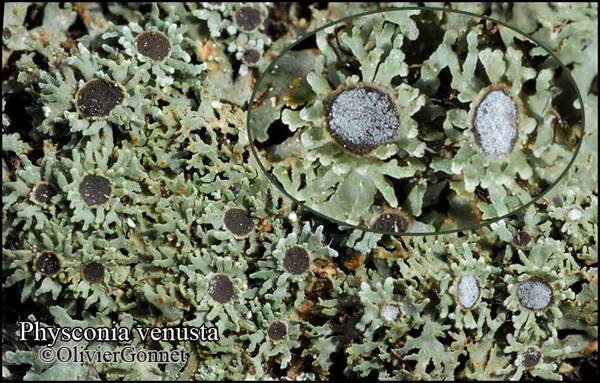
Courtesy Danièle et Olivier Gonnet - Source: https://www.afl-lichenologie.fr/Photos_AFL/Photos_AFL_P/Physconia_venusta.htm
France, 11/10/2018 - Ajaccio, Pointe de la Parata, alt.5 m - Corse

Courtesy Danièle et Olivier Gonnet - Source: https://www.afl-lichenologie.fr/Photos_AFL/Photos_AFL_P/Physconia_venusta.htm
France, 11/10/2018 - Ajaccio, Pointe de la Parata, alt.5 m - Corse
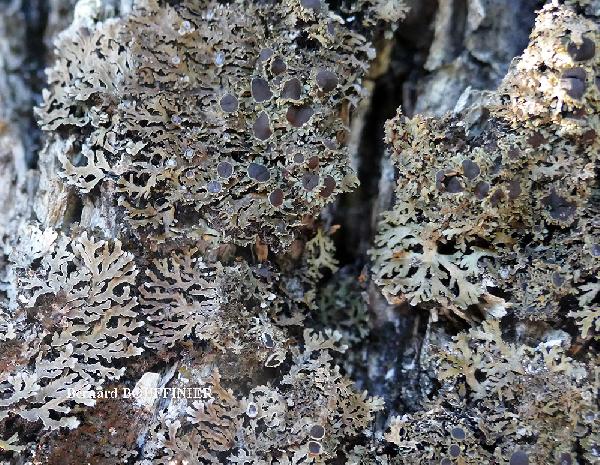
Bernard Bouffinier - Source: http://www.lichensmaritimes.org/index.php?task=fiche&lichen=759&lang=en
France, Corse, Murato
with Ph. distorta
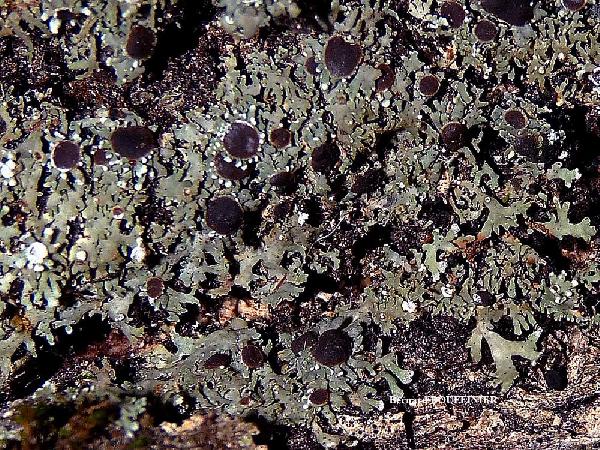
Bernard Bouffinier - Source: http://www.lichensmaritimes.org/index.php?task=fiche&lichen=759&lang=en
France, Corse, Tartagine
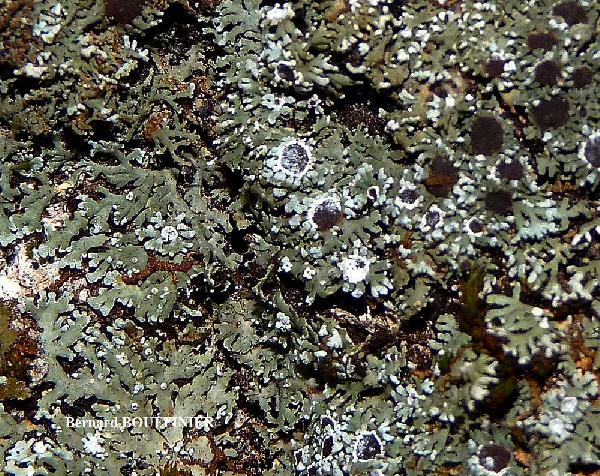
Bernard Bouffinier - Source: http://www.lichensmaritimes.org/index.php?task=fiche&lichen=759&lang=en
France, Corse, Tartagine
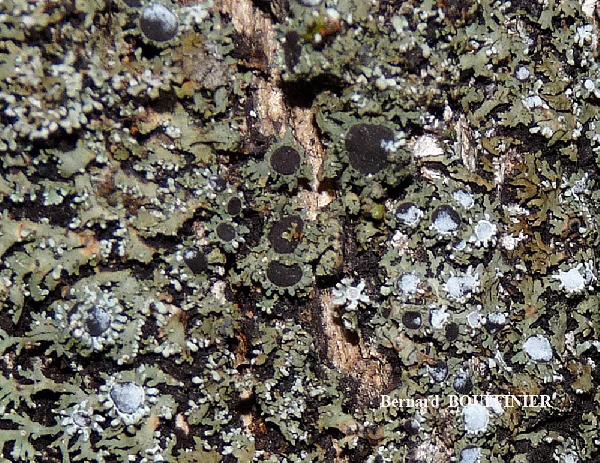
Bernard Bouffinier - Source: http://www.lichensmaritimes.org/index.php?task=fiche&lichen=759&lang=en
France, Corse, Tartagine
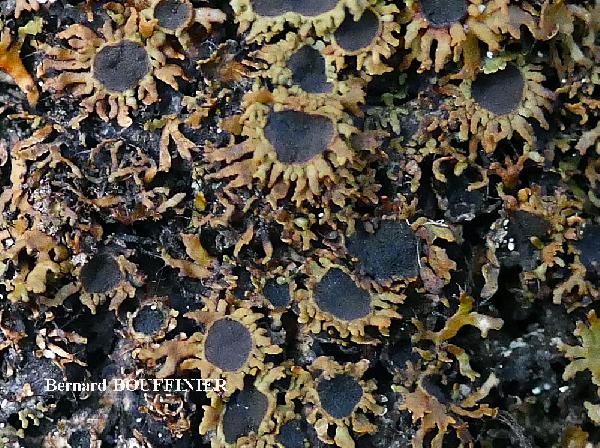
Bernard Bouffinier - Source: http://www.lichensmaritimes.org/index.php?task=fiche&lichen=759&lang=en
France, Corse, Murato
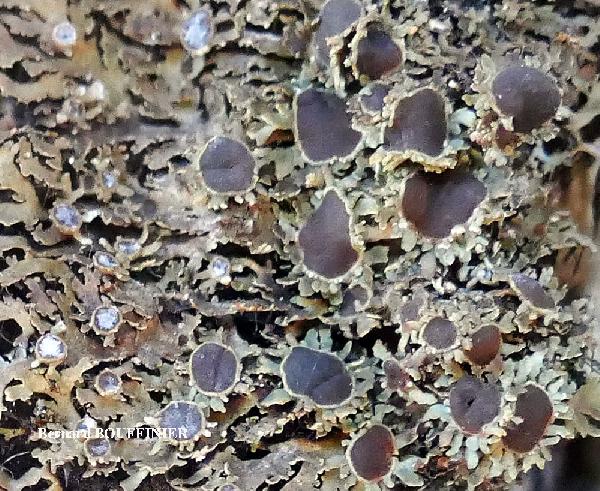
Bernard Bouffinier - Source: http://www.lichensmaritimes.org/index.php?task=fiche&lichen=759&lang=en
France, Corse, Murato
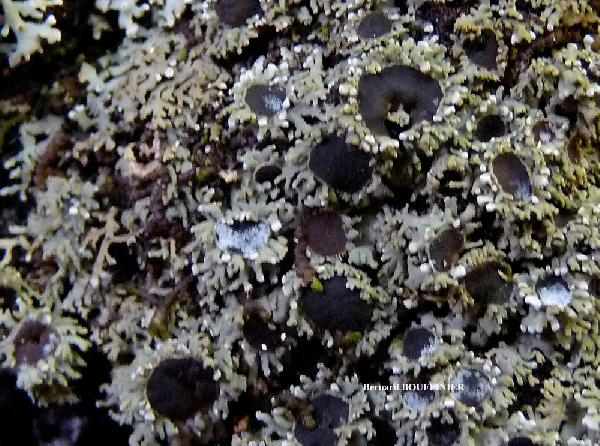
Bernard Bouffinier - Source: http://www.lichensmaritimes.org/index.php?task=fiche&lichen=759&lang=en
France, Corse, Piedicroce
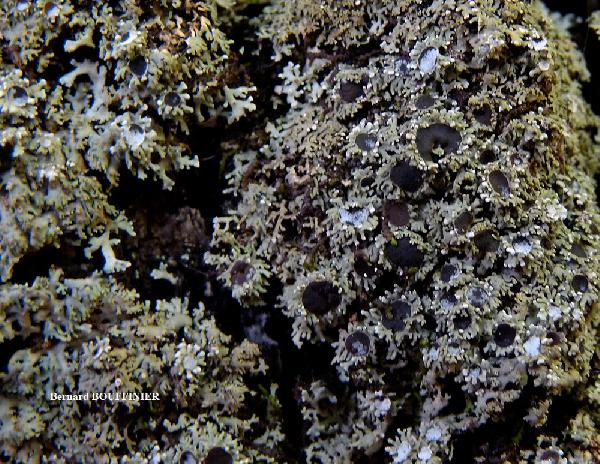
Bernard Bouffinier - Source: http://www.lichensmaritimes.org/index.php?task=fiche&lichen=759&lang=en
France, Corse, Piedicroce

Jacques Haine - Source: http://www.lichensmaritimes.org/index.php?task=fiche&lichen=759&lang=en
France, Corse, Forêt de San Petrone 1500 m
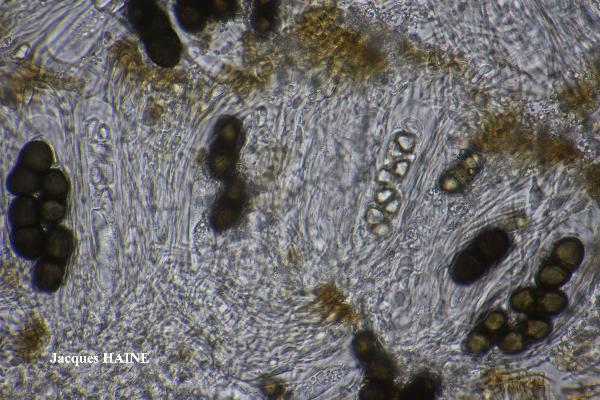
Jacques Haine - Source: http://www.lichensmaritimes.org/index.php?task=fiche&lichen=759&lang=en
France, Corse, Forêt de San Petrone 1500 m
Growth form: Foliose, narrow lobed
Substrata: bark
Photobiont: green algae other than Trentepohlia
Reproductive strategy: mainly sexual
Commonnes-rarity: (info)
Alpine belt: absent
Subalpine belt: absent
Oromediterranean belt: absent
Montane belt: very common
Submediterranean belt: extremely rare
Padanian area: absent
Humid submediterranean belt: rare
Humid mediterranean belt: absent
Dry mediterranean belt: absent

Predictive model
| Herbarium samples |


P.L. Nimis; Owner: Department of Life Sciences, University of Trieste
Herbarium: TSB (11435)
2001/12/05


P.L. Nimis; Owner: Department of Life Sciences, University of Trieste
Herbarium: TSB (34319)
2001/12/24


P.L. Nimis; Owner: Department of Life Sciences, University of Trieste
Herbarium: TSB (11435)
2001/12/05
detail of rhizines


P.L. Nimis; Owner: Department of Life Sciences, University of Trieste
Herbarium: TSB (34319)
2001/12/24
tip of lobes with pruina


Felix Schumm – CC BY-SA 4.0
[5163], Spanien, Gran Canaria, ca. 1,5 km südlich La Culata; felsiger trockener Nordhang, lückig mit Pinus canariensis bewachsen; 27°57.848 N, 15°36.136 W, 1570 m. Leg. F. Schumm & U Schwarz, 25.12.1998


Felix Schumm – CC BY-SA 4.0
[5163], Spanien, Gran Canaria, ca. 1,5 km südlich La Culata; felsiger trockener Nordhang, lückig mit Pinus canariensis bewachsen; 27°57.848 N, 15°36.136 W, 1570 m. Leg. F. Schumm & U Schwarz, 25.12.1998


Felix Schumm – CC BY-SA 4.0
[5163], Spanien, Gran Canaria, ca. 1,5 km südlich La Culata; felsiger trockener Nordhang, lückig mit Pinus canariensis bewachsen; 27°57.848 N, 15°36.136 W, 1570 m. Leg. F. Schumm & U Schwarz, 25.12.1998


Felix Schumm – CC BY-SA 4.0
[5163], Spanien, Gran Canaria, ca. 1,5 km südlich La Culata; felsiger trockener Nordhang, lückig mit Pinus canariensis bewachsen; 27°57.848 N, 15°36.136 W, 1570 m. Leg. F. Schumm & U Schwarz, 25.12.1998


Felix Schumm – CC BY-SA 4.0
[5163], Spanien, Gran Canaria, ca. 1,5 km südlich La Culata; felsiger trockener Nordhang, lückig mit Pinus canariensis bewachsen; 27°57.848 N, 15°36.136 W, 1570 m. Leg. F. Schumm & U Schwarz, 25.12.1998


Felix Schumm – CC BY-SA 4.0
[5163], Spanien, Gran Canaria, ca. 1,5 km südlich La Culata; felsiger trockener Nordhang, lückig mit Pinus canariensis bewachsen; 27°57.848 N, 15°36.136 W, 1570 m. Leg. F. Schumm & U Schwarz, 25.12.1998


Felix Schumm – CC BY-SA 4.0
[5163], Spanien, Gran Canaria, ca. 1,5 km südlich La Culata; felsiger trockener Nordhang, lückig mit Pinus canariensis bewachsen; 27°57.848 N, 15°36.136 W, 1570 m. Leg. F. Schumm & U Schwarz, 25.12.1998


Felix Schumm – CC BY-SA 4.0
[5163], Spanien, Gran Canaria, ca. 1,5 km südlich La Culata; felsiger trockener Nordhang, lückig mit Pinus canariensis bewachsen; 27°57.848 N, 15°36.136 W, 1570 m. Leg. F. Schumm & U Schwarz, 25.12.1998


Felix Schumm – CC BY-SA 4.0
[5163], Spanien, Gran Canaria, ca. 1,5 km südlich La Culata; felsiger trockener Nordhang, lückig mit Pinus canariensis bewachsen; 27°57.848 N, 15°36.136 W, 1570 m. Leg. F. Schumm & U Schwarz, 25.12.1998


Felix Schumm – CC BY-SA 4.0
[5163], Spanien, Gran Canaria, ca. 1,5 km südlich La Culata; felsiger trockener Nordhang, lückig mit Pinus canariensis bewachsen; 27°57.848 N, 15°36.136 W, 1570 m. Leg. F. Schumm & U Schwarz, 25.12.1998


Felix Schumm – CC BY-SA 4.0
[5163], Spanien, Gran Canaria, ca. 1,5 km südlich La Culata; felsiger trockener Nordhang, lückig mit Pinus canariensis bewachsen; 27°57.848 N, 15°36.136 W, 1570 m. Leg. F. Schumm & U Schwarz, 25.12.1998


Felix Schumm – CC BY-SA 4.0
[5163], Spanien, Gran Canaria, ca. 1,5 km südlich La Culata; felsiger trockener Nordhang, lückig mit Pinus canariensis bewachsen; 27°57.848 N, 15°36.136 W, 1570 m. Leg. F. Schumm & U Schwarz, 25.12.1998


Felix Schumm – CC BY-SA 4.0
[5163], Spanien, Gran Canaria, ca. 1,5 km südlich La Culata; felsiger trockener Nordhang, lückig mit Pinus canariensis bewachsen; 27°57.848 N, 15°36.136 W, 1570 m. Leg. F. Schumm & U Schwarz, 25.12.1998


Felix Schumm – CC BY-SA 4.0
[5163], Spanien, Gran Canaria, ca. 1,5 km südlich La Culata; felsiger trockener Nordhang, lückig mit Pinus canariensis bewachsen; 27°57.848 N, 15°36.136 W, 1570 m. Leg. F. Schumm & U Schwarz, 25.12.1998


Felix Schumm – CC BY-SA 4.0
[5163], Spanien, Gran Canaria, ca. 1,5 km südlich La Culata; felsiger trockener Nordhang, lückig mit Pinus canariensis bewachsen; 27°57.848 N, 15°36.136 W, 1570 m. Leg. F. Schumm & U Schwarz, 25.12.1998


Felix Schumm – CC BY-SA 4.0
[5163], Spanien, Gran Canaria, ca. 1,5 km südlich La Culata; felsiger trockener Nordhang, lückig mit Pinus canariensis bewachsen; 27°57.848 N, 15°36.136 W, 1570 m. Leg. F. Schumm & U Schwarz, 25.12.1998


Felix Schumm – CC BY-SA 4.0
Image from: F. Schumm (2008) - Flechten Madeiras, der Kanaren und Azoren. Beck, OHG - ISBN: 978-3-00-023700-3

Courtesy Danièle et Olivier Gonnet - Source: https://www.afl-lichenologie.fr/Photos_AFL/Photos_AFL_P/Physconia_venusta.htm
France, 11/10/2018 - Ajaccio, Pointe de la Parata, alt.5 m - Corse

Courtesy Danièle et Olivier Gonnet - Source: https://www.afl-lichenologie.fr/Photos_AFL/Photos_AFL_P/Physconia_venusta.htm
France, 11/10/2018 - Ajaccio, Pointe de la Parata, alt.5 m - Corse

Courtesy Danièle et Olivier Gonnet - Source: https://www.afl-lichenologie.fr/Photos_AFL/Photos_AFL_P/Physconia_venusta.htm
France, 11/10/2018 - Ajaccio, Pointe de la Parata, alt.5 m - Corse

Bernard Bouffinier - Source: http://www.lichensmaritimes.org/index.php?task=fiche&lichen=759&lang=en
France, Corse, Murato
with Ph. distorta

Bernard Bouffinier - Source: http://www.lichensmaritimes.org/index.php?task=fiche&lichen=759&lang=en
France, Corse, Tartagine

Bernard Bouffinier - Source: http://www.lichensmaritimes.org/index.php?task=fiche&lichen=759&lang=en
France, Corse, Tartagine

Bernard Bouffinier - Source: http://www.lichensmaritimes.org/index.php?task=fiche&lichen=759&lang=en
France, Corse, Tartagine

Bernard Bouffinier - Source: http://www.lichensmaritimes.org/index.php?task=fiche&lichen=759&lang=en
France, Corse, Murato

Bernard Bouffinier - Source: http://www.lichensmaritimes.org/index.php?task=fiche&lichen=759&lang=en
France, Corse, Murato

Bernard Bouffinier - Source: http://www.lichensmaritimes.org/index.php?task=fiche&lichen=759&lang=en
France, Corse, Piedicroce

Bernard Bouffinier - Source: http://www.lichensmaritimes.org/index.php?task=fiche&lichen=759&lang=en
France, Corse, Piedicroce

Jacques Haine - Source: http://www.lichensmaritimes.org/index.php?task=fiche&lichen=759&lang=en
France, Corse, Forêt de San Petrone 1500 m

 INDEX FUNGORUM
INDEX FUNGORUM
 GBIF
GBIF
 DOLICHENS
DOLICHENS
